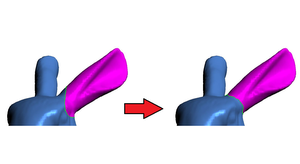Information
- Publication Type: Bachelor Thesis
- Workgroup(s)/Project(s):
- Date: December 2016
- Date (Start): July 2016
- Date (End): December 2016
- Matrikelnummer: e0926916
- First Supervisor: Michael Wimmer
Abstract
In this paper, I present a solution for migrating a curve on a three dimensional surface to the most concave isoline in its vicinity. Essentially, this problem statement tackles mesh segmentation from a different angle. The search for a suitable segmentation boundary is reduced to a shortest path problem. First, a graph is built using the mesh’s vertices and edges near the input curve. Then, the shortest path is found using the Dijkstra algorithm, whereas a modified weighting scheme that makes the passing through of concave edges cheaper, among other factors, results in a path suitable as segmentation boundary. The final algorithm provides segmentation boundaries of a quality similar to existing segmentation algorithms. The runtime generally lies below a second, thus making it viable for on the go optimization of the user’s input.Additional Files and Images
Weblinks
No further information available.BibTeX
@bachelorsthesis{Mayrhauser-2016-Cnc,
title = "Migration of Surface Curve to Most Concave Isoline",
author = "Maximilian Mayrhauser",
year = "2016",
abstract = "In this paper, I present a solution for migrating a curve on
a three dimensional surface to the most concave isoline in
its vicinity. Essentially, this problem statement tackles
mesh segmentation from a different angle. The search for a
suitable segmentation boundary is reduced to a shortest path
problem. First, a graph is built using the mesh’s vertices
and edges near the input curve. Then, the shortest path is
found using the Dijkstra algorithm, whereas a modified
weighting scheme that makes the passing through of concave
edges cheaper, among other factors, results in a path
suitable as segmentation boundary. The final algorithm
provides segmentation boundaries of a quality similar to
existing segmentation algorithms. The runtime generally lies
below a second, thus making it viable for on the go
optimization of the user’s input.",
month = dec,
address = "Favoritenstrasse 9-11/E193-02, A-1040 Vienna, Austria",
school = "Institute of Computer Graphics and Algorithms, Vienna
University of Technology ",
URL = "https://www.cg.tuwien.ac.at/research/publications/2016/Mayrhauser-2016-Cnc/",
}



